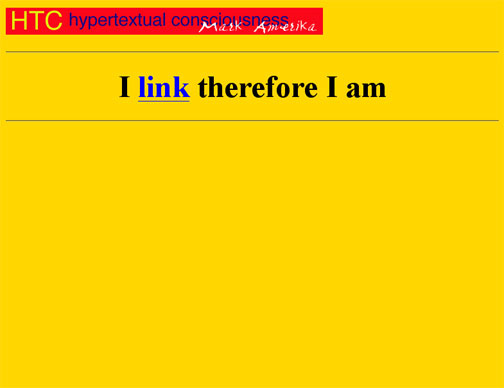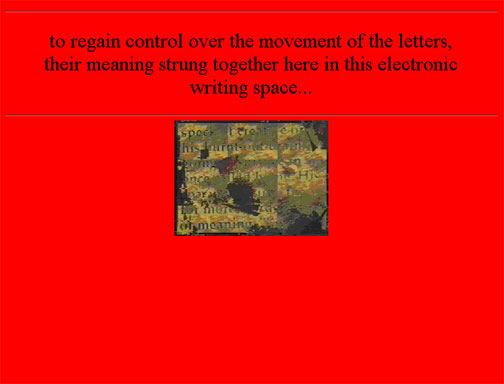GRAMMATRON is perhaps Mark Amerika’s most famous work of art. Exploding on to the digital art scene via the Web in early 1997, GRAMMATRON experiments with what were then emerging forms of art such as online hypertext narrative, Internet (or Net) art, and digitally expanded forms of cinema. GRAMMATRON invites the visitor to navigate through the narrative by clicking on the highlighted words while viewing the accompanying gallery of digitally animated and collage images that complement the text. The work also comes with its own WWW soundtrack featuring the vocals of Mark Amerika.
GRAMMATRON was the first part of Amerika’s major Internet art trilogy (followed by PHON:E:ME and FILMTEXT). GRAMMATRON experiments with what were then the new Graphical User Interfaces (GUIs) of the Web to create a unique work of art firmly rooted in the rival or avant-garde tradition of experimental literature.
In one interview, Amerika was asked “What is GRAMMATRON?”
His answer was that “GRAMMATRON is many things at once. It’s one of the earliest and more elaborate works of Internet Art created exclusively for the Web as a way to track the developments of ‘Web culture’ in a networked-narrative environment. I was especially interested in how some of the vaporware language that was coming out of the growing new media scene could be used against itself, to rub and/or remix alternative discourses together, everything from cyberpunk, dialectical materialism, and California ideology, to experimental narrative riffs from the likes of James Joyce, Arno Schmidt, and Jean-Luc Godard, to name a few.
Then there is the Cabala: the old scripture, the metacommentary, the Book of Creation, and the Golem myth. In many ways, GRAMMATRON is a retelling of the Golem myth remixed with narratological/rhetorical effects sampled from the alternative narratives and discourses mentioned earlier.
I also was very conscious that I wanted to experiment with many of the evolving technological features that the Web could offer me — features that I would never have reason to consider when writing my novels. So there are time-based meta-tags, javascript-encoded cookies that create alternative and/or random linking structures, some very detailed and labor-intensive animated gifs, and an original digital audio soundtrack, among other things.”
In many ways, the actual story being told in GRAMMATRON prophesizes the coming reign of viral marketing that was to take hold with the rise of the dot.com and the Internet bubble economy that appeared soon after its release. Anticipating what has now become an endless flow of unwanted email and instant messaging, the GRAMMATRON narrative satirizes the way computer networked environments become breeding grounds for unethical marketing practices, particularly the penetration of our creative and research spaces with the mindless info-spam of an invasive technocapitalism gone awry.
GRAMMATRON’s parallel investigation of spirituality in the electronic age touched on a subject that permeates most of Amerika’s work, namely, how does the contemporary artist, one who is bound by the historical circumstance they are born into, develop a personal aesthetic style in a culture of information that may at times stifle creativity? Amerika’s main strategy for addressing this issue in GRAMMATRON was to experiment with the media economy itself and to employ the new media technologies that were available to him at the time of production. By distributing his own narrative content through the Internet, Amerika was intentionally constructing an alternative art experience that investigates the positioning of reader-subjectivity in computer-mediated cyberspace. The work was considered a major breakthrough signaling a new form of contemporary media art and was selected for the 2000 Whitney Biennial of American Art. Since it’s release, GRAMMATRON has been exhibited on over 40 international venues and was included in the “The Conquest of Ubiquity” exhibition, an international retrospective of major works of Internet art that traveled throughout Spain in late 2003 and early 2004.
Upon its release, GRAMMATRON garnered over 500,000 visitors and was written about in the New York Times, MSNBC’s The Site, the Village Voice, Die Zeit, the Guardian, The Australian, Wired, and many other international media outlets.


